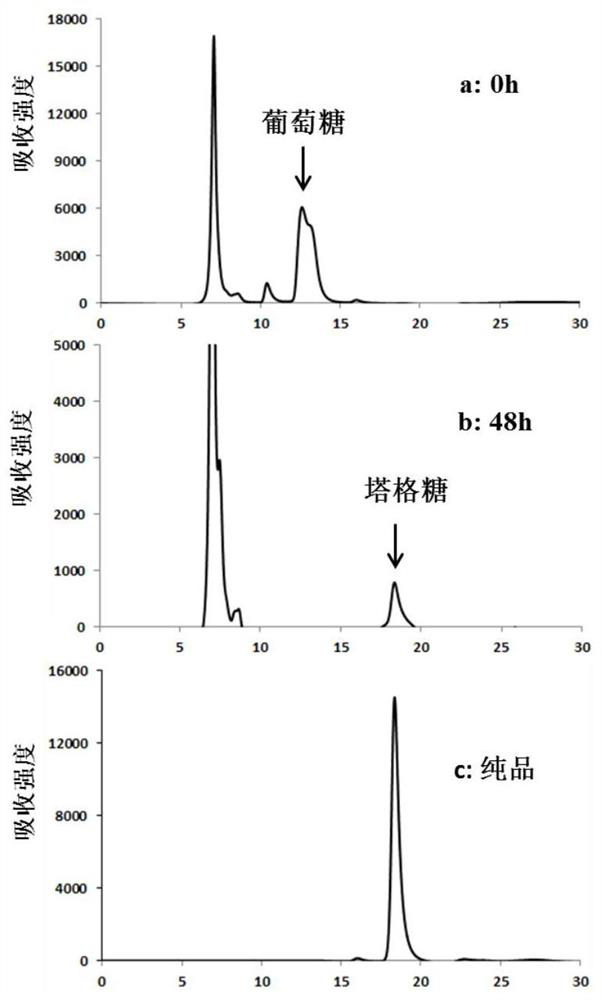An engineering strain producing tagatose, its construction method and application
A construction method and technology of engineering strains, applied in the fermentative production of tagatose, in the field of tagatose engineering bacteria, can solve the problems of tagatose production cost increase, not suitable for large-scale production, low yield, etc.
- Summary
- Abstract
- Description
- Claims
- Application Information
AI Technical Summary
Problems solved by technology
Method used
Image
Examples
Embodiment 1
[0028] Construction of Example 1 Corynebacterium glutamicum recombinant strain Tag1 and Tag2
[0029] 1. Construction of recombinant expression vector pEC-T6PE-T6PP1
[0030] According to the KEGG database, the 6-phosphate tagatose 4-epimerase T6PE gene (SEQ ID NO: 1) derived from Agrobacterium tumefaciens and the 6-phosphate psicose derived from Escherichia coli Phosphorylase T6PP gene (SEQ ID NO: 2), design primer 1, primer 2, primer 3 and primer 4, and obtain corresponding sequence by PCR amplification, gene T6PE1 and expression with restriction endonuclease SacI and SmaI simultaneously The vector pEC-XK99E (Kirchner O and Tauch A.2003, Tools for genetic engineering in the amino acid-producing bacterium Corynebacterium glutamicum.J.Biotechnol.104:287–299) was digested and ligated to obtain the recombinant plasmid pEC-T6PE1; further The gene T6PP1 and the expression vector pEC-T6PE1 were simultaneously digested and connected with restriction endonucleases SmaI and XbaI to o...
Embodiment 2
[0043] Construction of Example 2 Corynebacterium glutamicum recombinant strain Tag4
[0044] 1. Construction of the integration vector pK18mobsacB-pfk'
[0045] According to the upstream sequence (SEQ ID NO:10) and downstream sequence (SEQ ID NO:11) of the fructose 6-phosphate kinase gene derived from Corynebacterium glutamicum in the KEGG database, design primer 9, primer 10, primer 11 and primer 12, primer 9 and primer 10 were amplified by PCR to obtain the corresponding upstream sequence of the pfk' gene, and primer 9 and primer 10 were amplified by PCR to obtain the corresponding downstream sequence of the pfk" gene; the fusion PCR method was used to obtain the sequence consisting of the upstream and downstream sequences Fusion PCR fragment pfk'-pfk", further use restriction endonuclease EcoRI and HindIII fusion fragment pfk'-pfk" and vector pK18mobsacB( A, Tauch A, Jager W, Kal inowski J, Thierbach G, Puhler A. 1994. SmTag mobilizable multi-purpose cloning vectors deri...
Embodiment 3
[0057] The construction of embodiment 3 Corynebacterium glutamicum recombinant strain Tag5
[0058] 1. Construction of recombinant expression vector pXMJ19-GlK-PGI
[0059] According to the glucokinase GlK gene (SEQ ID NO:4) and the glucose 6-phosphate isomerase PGI gene (SEQ ID NO:5) derived from Corynebacterium glutamicum in the KEGG database, design primer 13, primer 14, primer 15 And primer 16, and take the Corynebacterium glutamicum genome as the gene pgi of template PCR amplification glucokinase gene glk and glucose 6-phosphate isomerase, simultaneously gene pgi and expression vector pXMJ19 with restriction endonuclease HindIII and PstI Carry out enzyme digestion, and connect with T4 ligase to obtain the expression vector pXMJ19-PGI; further use restriction endonuclease PstI and XbaI to carry out enzyme digestion on the gene glk and the expression vector pXMJ19-PGI at the same time, obtain the recombinant expression vector pXMJ19-GlK- PGI. The specific primer sequences...
PUM
 Login to View More
Login to View More Abstract
Description
Claims
Application Information
 Login to View More
Login to View More - R&D
- Intellectual Property
- Life Sciences
- Materials
- Tech Scout
- Unparalleled Data Quality
- Higher Quality Content
- 60% Fewer Hallucinations
Browse by: Latest US Patents, China's latest patents, Technical Efficacy Thesaurus, Application Domain, Technology Topic, Popular Technical Reports.
© 2025 PatSnap. All rights reserved.Legal|Privacy policy|Modern Slavery Act Transparency Statement|Sitemap|About US| Contact US: help@patsnap.com



